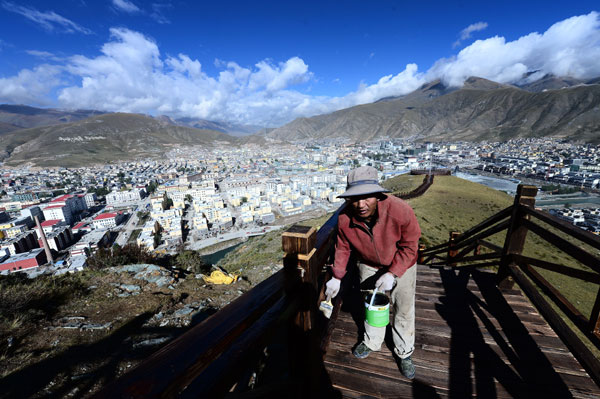 |
|
A worker paints a staircase at Dangdai Mountain in Jiegu township of Yushu in September. The area behind him took on a new look after rebuilding efforts. [Photo/Xinhua] |
Four years on, residents of quake-hit Yushu are receiving support to recover from the disaster but more is needed, reports Yang Wanli in Yushu, Qinghai province.
Kargu, a resident of the Yushu Tibetan autonomous prefecture in Qinghai province, gave birth to nine children at home.
"Herdsmen camp anywhere, following the grasslands with our yak and sheep. We have been accustomed to delivering our babies at home, even in tents," the 47-year-old said.
But when Kargu's own daughter Gartsok, 23, was pregnant with twins, doctors said both the babies were lying in difficult positions and needed medical attention.
So on July 30, Gartsok gave birth to the boys in the Dzatod county hospital in Yushu.
Kargu was with her daughter that day, and it was the first time for her to witness a woman giving birth in a hospital.
"Without the improvement of medical services in the county, my daughter might not have had her two sons safely," Kargu said.
Located at an average altitude of 4,200 meters, Yushu is linked to the Tibetan plateau and covers about 720,000 square kilometers with a population of about 5.7 million. Half of its residents include those from the Tibetan, Hui and Mongolian ethnic groups.
The sparsely populated prefecture has had few links with the more developed areas in central and western China. Most of its counties are connected with one-lane roads that snake through mountainous areas and turbulent rivers.
On April 14, 2010, a magnitude-7.1 earthquake hit Yushu city, the prefecture's capital, killing 2,698 people with 270 others still missing. Dzatod, about 250 km from the prefecture's capital, was also severely damaged in the quake.
Reconstruction and rebuilding efforts following the disaster have since helped to improve the lives of residents like Kargu and her family.
The county's hospital used to be in a single-storey brick house before the earthquake. It was the biggest hospital serving all 40,000 residents but had no more than 10 beds for patients.
"There were no separate departments in the hospital. A woman who gave birth would share the room with a patient who broke his knee," said Trashi Lhamo, assistant to the hospital chairman.
The scale and facilities of the hospital before the quake were no better than that of a residential medical center in a district in Beijing.
But after the tremor struck, the Red Cross Society of Shanxi province donated about 30 million yuan ($4.88 million) to rebuild the county's hospital with new facilities and medical equipment.
